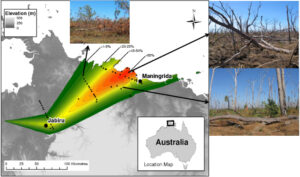In April 2006 severe tropical cyclone Monica swept across northern Australia. In its travels it harmed 10 400 km2 of tropical savanna, killing or severely damaging approximately 140 million trees and subsequently resulting in net equivalent CO2 emissions of 43 million tonnes – around 10% of Australia’s total annual GHG emissions or the equivalent of driving almost 9 million cars for a year.
These are just some of the findings of a recent collaborative study that utilised TERN landscape research infrastructure to better understand the impacts cyclones have on carbon dynamics in tropical savanna ecosystems.

A tree ‘isodamage’ map showing the spatial extent of damage across the impact area of TC Monica as determined from wind analysis plus aerial and on-ground tree damage surveys. The contour lines and colours on the map represent tree damage severity, ranging from 1–5% tree damage in green to >85% in red. Picture insets show post-cyclone vegetation from contrasting damage polygons 1–5% (top left), >85% (top right) and 40–45% (mid-right) (pictures courtesy of Dr Garry Cook, CSIRO)
It is a well-known fact that climate and disturbances like cyclones, fire, pests and termites drive ecosystem dynamics. Extreme events, such as cyclones, can change ecosystem structure, species composition and landscape productivity, just to name a few. We understand a lot about the impacts of cyclones on the structure and function of forest ecosystems; however, until now, little has been known about how cyclones affect tropical savannas. In particular, what has the greatest impact on savanna ecosystem carbon balance: infrequent but severe cyclones or regular less intense disturbances such as fires and termite herbivory (eating of plant matter)?
To answer this question and more, the study’s collaborative team of climate and ecosystem scientists from universities across Australia looked to TERN to satisfy their data requirements. The investigation into the relationships between cyclone events and greenhouse gas emissions from Australia’s tropical savannas utilised remotely sensed estimates of Gross Primary Productivity (GPP) data developed for Australia by TERN’s AusCover Facility. It also utilsed data from the TERN OzFlux site at Howard Springs to assess the impact of fire of GPP.
The study, which involved Charles Darwin University, Macquarie University, Monash University, University of Western Australia and CSIRO, used the data to demonstrate the importance of understanding how climate variability and disturbance impacts savanna productivity in the context of the increasing interest in using savanna landscapes for enhanced carbon sinks in emission offset schemes.
Lead author and manager of TERN’s Litchfield Savanna SuperSite, Associate Professor Lindsay Hutley, says that ‘having open access to quality data from TERN’s AusCover Facility was vital for the completion of our research’.
‘Prior to TERN this study would not have been possible. The combination of capabilities cross the TERN platforms (AusCover and OzFlux) along with collaboration for the TERN’s e-Mast Facility director (Dr Brad Evans) has facilitated this program,’ adds co-author Professor Jason Beringer of Monash University.
TERN’s data was used in the study’s comparison of the impacts of severe but infrequent cyclonic disturbance on savanna with the more frequent but less severe disturbances of fires and continual termite herbivory. Despite having severe effects on the ecosystem carbon balance, the study found that the ‘long term impacts on savanna carbon balance are likely to be dominated by fire and termite consumption rather than infrequent extreme mega-cyclones’ says fellow author Dr Brad Evans.
The study is important to help manage these savanna ecosystems with an expected increase in extreme events, such as cyclones, and with possible increased fire risk due to climate change. Collaborative ground-breaking research such as this will play an important role in understanding how best to offset Australia’s carbon footprint and contribute to the effective management of our unique ecosystems.
The team’s findings have been published in a special issue on extreme climate and carbon cycle in the journal Environmental Research Letters and is available online now. The AusCover data that was used in this study is now freely available via TERN’s Data Discovery Portal.


Global cyclone tracks in relation to savanna ecosystems (yellow ‘Ss’). Australia is one of only a handful of countries that has the unique opportunity to study the impacts cyclones have on savanna ecosystems.
Published in TERN newsletter January 2014






